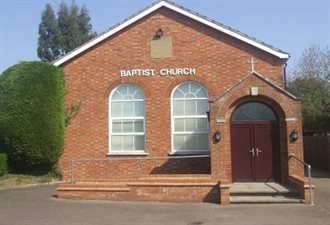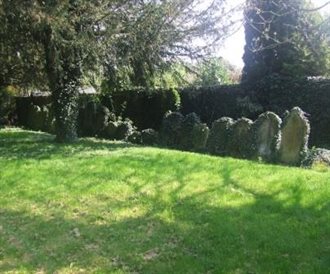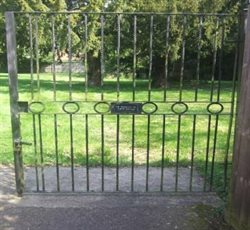Cranfield Baptist Church
This page was written by Sally Williams
Note: this account of the Cranfield Baptist Church is taken from the booklet Cranfield Baptist Church 1660-1960 by HG Tibbutt. The full booklet can be obtained from the church.

Cranfield Baptist Church. Photograph Sally Williams
It is likely that there were informal meetings of followers before 1660 but this is the date given for when William Wheeler formalised arrangements in Cranfield. Wheeler is thought to have been associated with the parish church in Cranfield before becoming a nonconformist. Other prominent members at this time were Messrs Donne and Gibbs. Between them they also appear to have supported services in other churches: records show that Wheeler, Donne and Gibbs helped at the Bedford church when the regular pastor, John Burton was ill.
The early years of the Cranfield group are not well documented but it is known that this period was a difficult time for Dissenters. At some time in late 1664 or early 1665, Wheeler was committed to the county jail at Bedford, the jail in which John Bunyan was already a prisoner. During his incarceration William Wheeler sent a petition to the King Charles II seeking his release on health grounds and also for the sake of his wife and nine small children. He died in 1668 and in his will he described himself as “clerk”.
In 1669, the Return of the Conventicles listed two independent meetings in Cranfield, one under the leadership of Gibbs and one under Garvas, alias Jarvas, a weaver from Ridgmont.
After the 1672 Declaration of Indulgence, licences were granted for two meeting houses, one at the home of William Armes and the other at the home of George Palmer. Thomas Kent was licensed to preach in the village.
Tradition has it that Nehemiah Coxe was pastor at Cranfield until 1742 when he was buried in the Meeting House ground.
In the eighteenth century numerous documents, including a return of Dissenting meetings and preachers, show that there were strong links between the causes at Cranfield and Ridgmont.
A census taken at the beginning of the 19th century shows that between 1801 and 1811, there were seven births and fourteen burials of Anabaptists in Cranfield. By now, the church building at East End was proving too small and was enlarged at a cost of £200, almost all of which was paid by Thomas Odell, one of the deacons. After an enlargement, the East End meeting house was reopened in June 1833. Weekly prayer meetings were established in 1805 and the Sunday school was started in March 1807.
By 1840, the church had 62 members with 80 Sunday School scholars and two village preaching stations. The membership had dropped by the 1850s to 50 or fewer members. This was due to the secession of some members to form a second Baptist Church, later known as Mount Zion Chapel. This church faded after around 50 years and many of its surviving members returned to the East End church.

Burial ground at the Baptist Church [Photograph Sally Williams]
In 1858, the graveyard was extended when some land was donated by William Woods.
By 1870 the church had 79 members with 118 Sunday School scholars. A notable pastor at this time was Thomas Owen who preached at Cranfield from 1841 until his resignation in 1870. He died in 1875 and is buried in the graveyard. A new school room was put up in 1880, the year of the Centennial of Sunday schools.
In September 1960, the tercentenary year of the church, the Bedfordshire union held its autumn meetings at Cranfield and a new pulpit Bible, specially purchased for the tercentenary year was signed by the President of the Bedfordshire Union, S.G. Smith.

Entrance to burial ground at the Baptist Church [Photograph Sally Williams]
The church holds some burial certificates for those buried in the graveyard which can be obtained from the church officials.